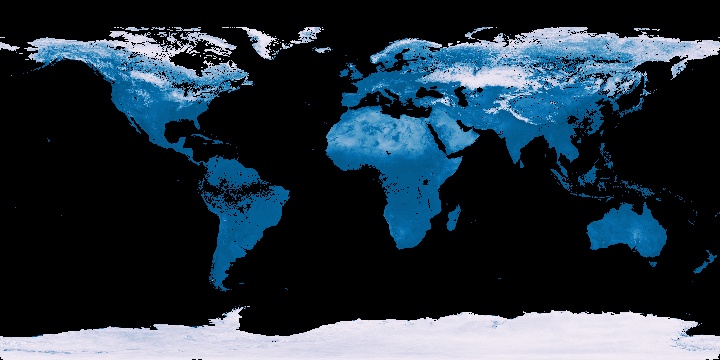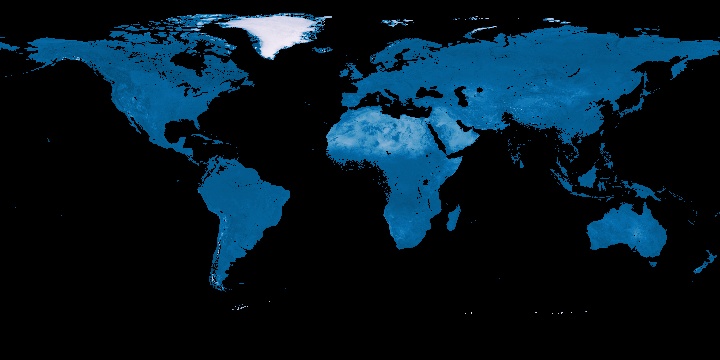Albedo: Difference between revisions
No edit summary |
Energy>Jmdonev No edit summary |
||
| Line 1: | Line 1: | ||
[[Category:Done | [[Category:Done 2020-01-31]] | ||
[[File:Roof-albedo.gif| | [[File:Roof-albedo.gif|480px|framed|right|Figure 1. Albedos of different surfaces.<ref>Wikimedia Commons. (September 26, 2015). ''Roof Albedo'' [Online]. Available: https://upload.wikimedia.org/wikipedia/commons/6/6a/Roof-albedo.gif</ref> An albedo of 1 would mean a perfect reflector and an albedo of 0 would absorb all light striking it.]] | ||
<onlyinclude>'''Albedo''' is the amount of [[solar radiation]] | <onlyinclude>'''Albedo''' is the amount of [[sunlight]] ([[solar radiation]]) reflected by a surface, and is usually expressed as a [[percent]]age or a decimal value, with 1 being a perfect reflector and 0 absorbing all incoming light. When talking about albedo, the surface is almost always the surface of a planet like Earth.<ref>ESR. (September 26, 2015). ''Albedo'' [Online]. Available: https://www.esr.org/outreach/glossary/albedo.html</ref> White objects, such as a snowy hill have a high albedo. Conversely, dark objects, like pavement, have a low albedo.<ref name=IPCC_SREX>IPCC, 2012: Glossary of terms. In: Managing the Risks of Extreme Events and Disasters to Advance Climate Change Adaptation [Field, C.B., V. Barros, T.F. Stocker, D. Qin, D.J. Dokken, K.L. Ebi, M.D. Mastrandrea, K.J. Mach, G.-K. Plattner, S.K. Allen, M. Tignor, and P.M. Midgley (eds.)]. A Special Report of Working Groups I and II of the Intergovernmental Panel on Climate Change (IPCC). Cambridge University Press, Cambridge, UK, and New York, NY, USA, pp. 555-564.</ref></onlyinclude> The term can also refer to human made structures. In fact, [[energy efficient building design]] takes albedo into consideration whether a wall or ceiling warms the building or keeps it cool - resulting in a choice of a dark or light coating respectively. | ||
For a given area, albedo is determined by more than just the composition of soil, it's impacted by soil moisture, type of vegetation, and levels of urbanization. Different surfaces on the Earth have different albedos (shown in Figure 1) and that albedo varies with time. Changes in albedo occur as the amount of [[cloud]] cover changes. Likewise, changes in any surface cover, like snow, ice, and vegetation, shift the albedo. Albedo is one of the major properties that controls how much [[energy]] is absorbed by the surface of the Earth, the cloudiness and ground cover are important factors in [[climate]] models. | |||
The Earth's surface doesn't have a single albedo, rather a number of different albedos that are combined into a single number to accurately describe how the Earth reflects and absorbs solar energy as a whole. Figures 2 and 3 below illustrate different albedos around the world, and how those albedos change depending on the time of year. For both images, high albedos are represented by the colour white while lower albedos are a dark blue. | |||
[[File:february.jpeg|400px|framed|center|Figure 2. Albedo values for the Earth for February 2015.<ref name=nasa>NASA Earth Observatory. (September 26, 2015). ''Albedo'' [Online]. Available: http://neo.sci.gsfc.nasa.gov/view.php?datasetId=MCD43C3_M_BSA</ref>]] | [[File:february.jpeg|400px|framed|center|Figure 2. Albedo values for the Earth for February 2015.<ref name=nasa>NASA Earth Observatory. (September 26, 2015). ''Albedo'' [Online]. Available: http://neo.sci.gsfc.nasa.gov/view.php?datasetId=MCD43C3_M_BSA</ref>]] | ||
| Line 13: | Line 13: | ||
==Climate Change== | ==Climate Change== | ||
The | The Earth's climate depends on a balance of incoming and outgoing energy from the sun, which is determined by albedo. The overall albedo of the Earth - measured to be 0.30 - has a significant effect on the equilibrium [[temperature]] of the Earth as it changes how much solar energy is reflected by the Earth as opposed to how much is absorbed.<ref>Measuring the Earth's Albedo, Accessed March 30th, 2019. https://earthobservatory.nasa.gov/images/84499/measuring-earths-albedo</ref> This changes how [[Earth's energy budget]] balances and thus changes [[Earth's heat balance]]. | ||
[[Global warming]] | As the [[Global warming|world warms]] the Earth's albedo shifts. The amount of ice covering the planet is dropping as a result of increased temperatures from global warming. This causes a decrease in the area of white surfaces, leading to less energy to be reflected and more to be absorbed. This process warms the Earth even more. The melting of Arctic ice is especially concerning as it triggers a [[positive feedback]] (a [[feedback cycle]] that drives the climate out of control). In addition to melting ice, which lowers albedo, the conditions caused as a result of the [[greenhouse effect]] can also change the albedo of the Earth. The greenhouse effect can lower the albedo of the Earth by trapping in more [[infrared radiation]] with the increased number of [[greenhouse gas]]es in the atmosphere, allowing less energy to bounce off of the [[atmosphere]]. Since the greenhouse effect can lower the albedo of the Earth and a changing albedo can result in a change in the equilibrium temperature of the Earth, a change in albedo can contribute to climate change.<ref name=hyperphysics>HyperPhysics. (March 30, 2019). ''Albedo of the Earth'' [Online]. Available: http://hyperphysics.phy-astr.gsu.edu/hbase/phyopt/albedo.html</ref> | ||
<html> | |||
<iframe width="560" height="315" src="https://www.youtube.com/embed/uVkfh89iyeU" frameborder="0" allow="accelerometer; autoplay; encrypted-media; gyroscope; picture-in-picture" allowfullscreen></iframe> | |||
</html> | |||
For information on how the Earth's albedo is measured please see NASA's site, [http://earthobservatory.nasa.gov/IOTD/view.php?id=84499 measuring the Earth's albedo]. | For information on how the Earth's albedo is measured please see NASA's site, [http://earthobservatory.nasa.gov/IOTD/view.php?id=84499 measuring the Earth's albedo]. | ||
==For Further Reading== | |||
*[[Climate change]] | |||
*[[Climate forcing]] | |||
*[[Blackbody radiation]] | |||
*[[Positive climate feedback]] | |||
*Or explore a [[Special:Random|random page]] | |||
==References== | ==References== | ||
{{reflist}}[[Category:Uploaded]] | {{reflist}} | ||
[[Category:Uploaded]] | |||
Revision as of 22:50, 26 January 2020

Albedo is the amount of sunlight (solar radiation) reflected by a surface, and is usually expressed as a percentage or a decimal value, with 1 being a perfect reflector and 0 absorbing all incoming light. When talking about albedo, the surface is almost always the surface of a planet like Earth.[2] White objects, such as a snowy hill have a high albedo. Conversely, dark objects, like pavement, have a low albedo.[3] The term can also refer to human made structures. In fact, energy efficient building design takes albedo into consideration whether a wall or ceiling warms the building or keeps it cool - resulting in a choice of a dark or light coating respectively.
For a given area, albedo is determined by more than just the composition of soil, it's impacted by soil moisture, type of vegetation, and levels of urbanization. Different surfaces on the Earth have different albedos (shown in Figure 1) and that albedo varies with time. Changes in albedo occur as the amount of cloud cover changes. Likewise, changes in any surface cover, like snow, ice, and vegetation, shift the albedo. Albedo is one of the major properties that controls how much energy is absorbed by the surface of the Earth, the cloudiness and ground cover are important factors in climate models.
The Earth's surface doesn't have a single albedo, rather a number of different albedos that are combined into a single number to accurately describe how the Earth reflects and absorbs solar energy as a whole. Figures 2 and 3 below illustrate different albedos around the world, and how those albedos change depending on the time of year. For both images, high albedos are represented by the colour white while lower albedos are a dark blue.


Climate Change
The Earth's climate depends on a balance of incoming and outgoing energy from the sun, which is determined by albedo. The overall albedo of the Earth - measured to be 0.30 - has a significant effect on the equilibrium temperature of the Earth as it changes how much solar energy is reflected by the Earth as opposed to how much is absorbed.[5] This changes how Earth's energy budget balances and thus changes Earth's heat balance.
As the world warms the Earth's albedo shifts. The amount of ice covering the planet is dropping as a result of increased temperatures from global warming. This causes a decrease in the area of white surfaces, leading to less energy to be reflected and more to be absorbed. This process warms the Earth even more. The melting of Arctic ice is especially concerning as it triggers a positive feedback (a feedback cycle that drives the climate out of control). In addition to melting ice, which lowers albedo, the conditions caused as a result of the greenhouse effect can also change the albedo of the Earth. The greenhouse effect can lower the albedo of the Earth by trapping in more infrared radiation with the increased number of greenhouse gases in the atmosphere, allowing less energy to bounce off of the atmosphere. Since the greenhouse effect can lower the albedo of the Earth and a changing albedo can result in a change in the equilibrium temperature of the Earth, a change in albedo can contribute to climate change.[6]
For information on how the Earth's albedo is measured please see NASA's site, measuring the Earth's albedo.
For Further Reading
- Climate change
- Climate forcing
- Blackbody radiation
- Positive climate feedback
- Or explore a random page
References
- ↑ Wikimedia Commons. (September 26, 2015). Roof Albedo [Online]. Available: https://upload.wikimedia.org/wikipedia/commons/6/6a/Roof-albedo.gif
- ↑ ESR. (September 26, 2015). Albedo [Online]. Available: https://www.esr.org/outreach/glossary/albedo.html
- ↑ IPCC, 2012: Glossary of terms. In: Managing the Risks of Extreme Events and Disasters to Advance Climate Change Adaptation [Field, C.B., V. Barros, T.F. Stocker, D. Qin, D.J. Dokken, K.L. Ebi, M.D. Mastrandrea, K.J. Mach, G.-K. Plattner, S.K. Allen, M. Tignor, and P.M. Midgley (eds.)]. A Special Report of Working Groups I and II of the Intergovernmental Panel on Climate Change (IPCC). Cambridge University Press, Cambridge, UK, and New York, NY, USA, pp. 555-564.
- ↑ 4.0 4.1 NASA Earth Observatory. (September 26, 2015). Albedo [Online]. Available: http://neo.sci.gsfc.nasa.gov/view.php?datasetId=MCD43C3_M_BSA
- ↑ Measuring the Earth's Albedo, Accessed March 30th, 2019. https://earthobservatory.nasa.gov/images/84499/measuring-earths-albedo
- ↑ HyperPhysics. (March 30, 2019). Albedo of the Earth [Online]. Available: http://hyperphysics.phy-astr.gsu.edu/hbase/phyopt/albedo.html

